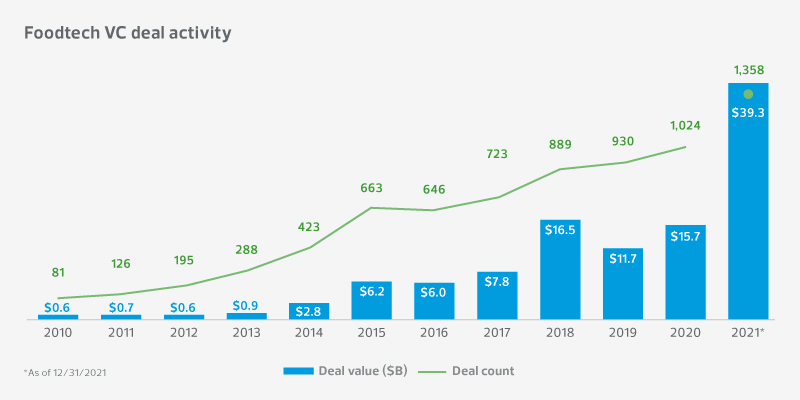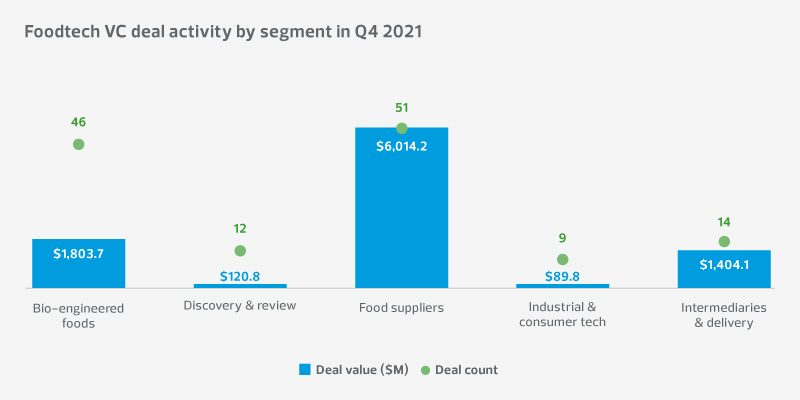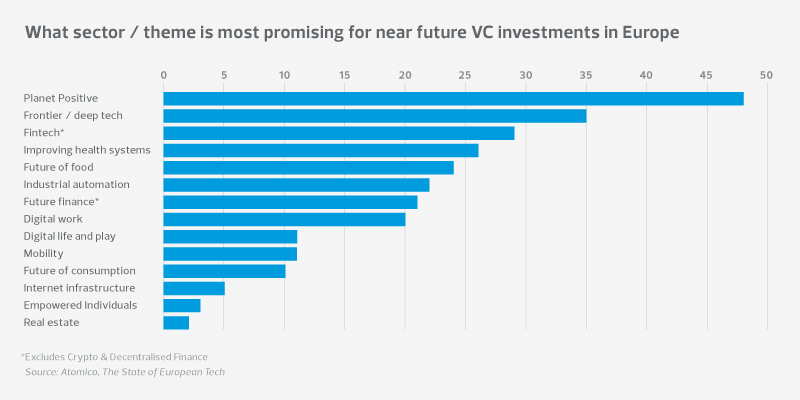08 March 2022
With global populations rising to 8 billion there is a clear captive market for FoodTech offerings. Venture capital deal activity rose to highs of almost $40bn in 2021. Most of us will have used a FoodTech product in the last 12 months whether you are ordering a meal on Deliveroo or expanding your palette to try a novel cuisine.

What is the FoodTech market?
It’s helpful to think about FoodTech as five markets. Bio-engineered foods look to bring new flavours to our diet or use technology to replicate existing flavours. Plant-based proteins, cultivated proteins, fermented proteins and novel ingredients (read: insects) are increasingly part of our diet globally.
Platform based products allows us to explore new foods. Restaurant review apps, wine trading platforms and personalised diets are examples of emerging technologies in this space.
Food suppliers saw a boom in 2021 – with huge levels of uptake in the pandemic. As consumers we might be ordering meal kits or groceries as the broader industry embraces greater numbers of ghost kitchens and tech enabled catering options.
Improvements in robotics and artificial intelligence is creating a market for industrial and consumer technologies – smart ovens will become robot chefs. Increased focus on the planet positivity (see below) has led to a boom in businesses that monitor and improve both food waste and traceability.
The pandemic accelerated the use of intermediary and delivery apps across the globe. However it is the advancements in robotics that creates really exciting ways for food to be is delivered to your door. Funky little delivery robots with integrated heating or cooling compartments to deliver your food in the best condition possible is a distinct possibility.

Emerging from the pandemic into the new normal
We turned to technology to find food for our households in the pandemic. In these early days online ordering and delivery was the only way households to secure food. We didn’t realise the comfort we took from a regular food shop until we couldn’t do it due to social distancing restrictions. In addition to this for many more time at home meant more time to cook and experiment – fuelling a surge in online interest for recipes and ideas.
Users and investors rushed to FoodTech and in particular the delivery platforms. Eat Just raised $200m in March 2021 with a further $276m in September 2021. Deliveroo’s IPO in May 2021 hit the headlines. Food businesses were forced to invest in technology to adapt to a digitally enabled world of the present, with a mind to being future-proof. As we emerge tentatively from the pandemic many of us have adjusted to using these digital platforms to source food for good. We have swapped the daily supermarket shop for online delivery and we prefer to eat delivered food from our favourite restaurants in front of Netflix. The prospects for FoodTech businesses that are focussed on discovery & review and delivery in particular are strong as we look forward. Challenges to these early stage businesses may come from BigTech – giants such as Amazon have the existing infrastructure and customer base to swamp their rivals as they invest in this area. FoodTech businesses may find support and capital by plugging into BigTech. ‘Final mile’ delivery is estimated to cost as much as 28 per cent of the total journey. Cost effective, safe and fun technologies such as robots or drones to navigate the end of the journey will be very attractive as business partners or acquisition targets.
Rising populations and the role of planet positive
As population levels rise across the world there are increasing concerns that existing food supplies will not meet demand. These concerns link with changing eating habits that are planet positive. ‘Meat alternative’ and ‘vegetarian’ searches on Google surged around the COP26 conference in late 2020 as we looked to consider expanding our diets.
Meat options are being replaced with ‘protein’. Emerging technologies are being used to replace meat with bio-engineered foods. For many, the first step will be embracing alternative proteins such as Impossible’s plant-based burgers. Over time we may be open to trying more unusual novel ingredients. Insect protein for example has been identified as a sustainable and low-cost source of protein.
Tech-enabled improvements in farming methods will lead to crops that are more nutritious, can be grown faster and outside of traditional farming cycles. Vertical farms can be built and placed in city centres, dramatically reducing food miles and waste on delivery. Increased use of robots and automation will replace labour intensive roles with potential gains in efficiency.
A warning - meat alternatives and greater amounts of vegetables in our diet is not automatically planet positive. These technologies may require greater amounts of energy than traditional methods to produce at greater scales. Many consumers will expect these new food products to be good for the planet and energy to grow may become a crucial element of selecting items to eat. Accordingly, ESG will be high on the agenda of most FoodTech businesses.
The magic ingredients for companies seeking investment may be planet positivity, ground-breaking science and future of food. In the recent Atomic report ‘State of European Tech’ these were identified by fund managers as three of the top five areas of future promise.

What’s on the menu in the future – deep fried crickets delivered by robots?
Consumer habits have been fundamentally changed by the pandemic. Many of us have embraced technology and changed our habits for good. FoodTech businesses will be looking to leverage technology to meet this new demand and access new markets. Technology will provide some of the answers to the key questions – for example how to reduce the cost of delivery over the ‘final mile’.
Increased investment in FoodTech ideas and concepts will be required to ensure that we have healthy food for everybody that is grown in a sustainable way. The positive news is that there is appetite to provide this investment and try new ideas. Deep fried crickets as a novel food solution might sound unappealing for some, but many will be looking to ensure their diet is both nutritious and planet positive.









